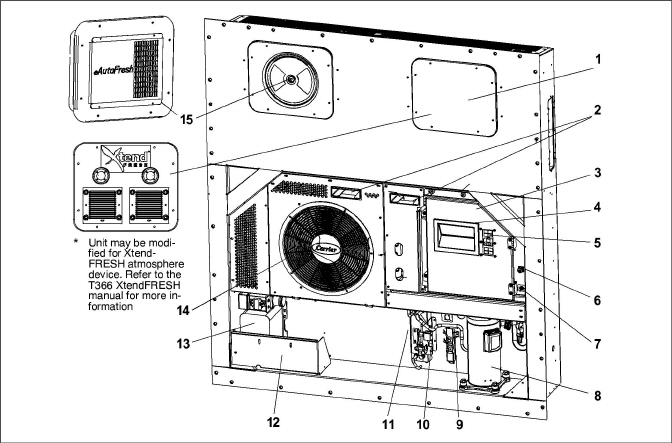
Section 3
3.1.1Refrigeration Unit - Front Section
The unit is designed so that the majority of the components are accessible from the front (see Figure 3.1). The unit model number, serial number and parts identification number can be found on the serial plate on the back wall of the condenser section.
The function of the upper or lower makeup air vent is to provide ventilation for commodities that require fresh air circulation. A manually operated venting system is located in the upper left access panel.
The optional eAutoFresh vent system is used to moderate the atmospheric level in the container in response to cargo respiration. When transporting frozen cargo loads the vent will be closed. The upper left access panel contains the vent slide and motor assembly. It may be removed to allow entry into the evaporator section where the CO2 sensor and drive pack are located.
Figure 3.1 Refrigeration Unit - Front Section

6.Remote Monitoring Receptacle
9.Supply Temperature Supply/Recorder Sensor Assembly (STS/SRS)
11.Ambient Temperature Sensor (AMBS)
12.Power Cables and Plug (Location)
15.Upper Fresh Air Makeup Vent Panel (Evap. Fan #2)
- - - - -
The evaporator section is shown below. The evaporator fans circulate air through the container by pulling it in the top of the unit, directing it through the evaporator coil where it is heated or cooled, and discharging it at the bottom.
If the unit is provisioned for XtendFRESH or equipped with eAutoFresh, system components are mounted in addition to the standard refrigeration unit components. The stepper motor component is installed in the vent; the air filter, CO2 sensor, stepper motor drive and CO2 sensing lines are installed on the rib of the upper grill.
Most evaporator components are accessible by removing the upper rear panel (as shown in the illustration) or by removing the evaporator fan access panels (see Figure 3.2).
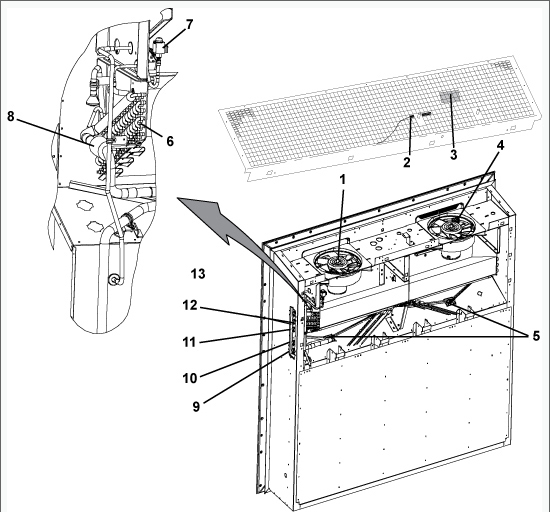
1.Evaporator Fan Motor #1 (EM1)
2.Return Recorder Sensor / Temperature Sensor (RRS/RTS)
4.Evaporator Fan Motor #2 (EM2)
5.Evaporator Coil Heaters (Underside of Coil)
7.Electronic Expansion Valve (EEV)
8.Evaporator Temperature Sensors (Location) (ETS1 & ETS2)
9.Interrogator Connector (Rear) (ICR)
- - - - -
The compressor section includes the compressor, digital loader valve (DLV), digital unloader valve (DUV), high pressure switch (HPS), discharge pressure transducer (DPT), evaporator pressure transducer (EPT) and the suction pressure transducer (SPT).
The supply temperature sensor and supply recorder sensor are located to the left of the compressor.
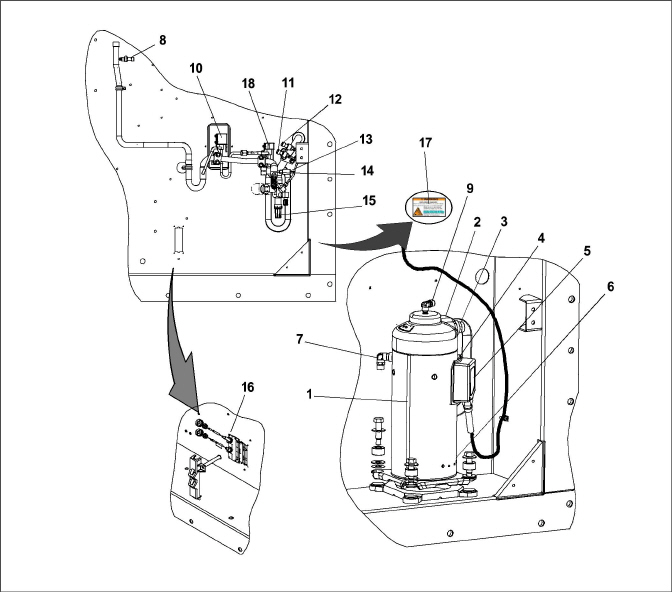
2.Compressor Discharge Temperature Sensor (CPDS) (Location)
4.Suction Connection (Location)
8.Discharge Pressure Transducer (DPT)
11.Suction Pressure Transducer (SPT)
12.Evaporator Pressure Transducer (EPT)
16.Supply Temperature/Supply Recorder Sensor Assembly (STS/SRS)
18.Digital Unloader Valve (DUV)
- - - - -
3.1.5Air-Cooled Condenser Section
The air-cooled condenser section consists of the condenser fan, condenser coil, receiver, liquid line service valve, filter drier, fusible plug, economizer, economizer expansion valve, economizer solenoid valve (ESV), and sight glass/moisture indicator.
The condenser fan pulls air from around the coil and discharges it horizontally through the condenser fan grille.
Figure 3.4 Air-Cooled Condenser Section
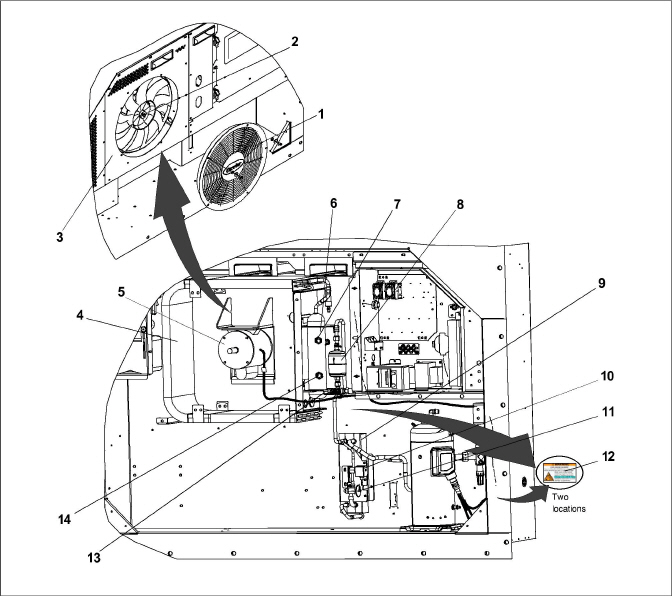
10.Economizer Solenoid Valve (ESV)
14.Liquid Level/Moisture Indicator
- - - - -
3.1.6Water-Cooled Condenser Section
The unit may contain a water-cooled condenser (WCC) installed as an option. When operating on the water-cooled condenser, the condenser fan is deactivated by a water pressure switch or condenser fan switch.
The brazed plate water-cooled condenser section (Figure 3.5) consists of the brazed plate water-cooled condenser (WCC), water couplings, a water pressure switch and a fusible plug. The receiver is retained in this configuration and the brazed plate heat exchanger is placed between the air-cooled condenser and the receiver.
Figure 3.5 Brazed-Plate Water-Cooled Condenser
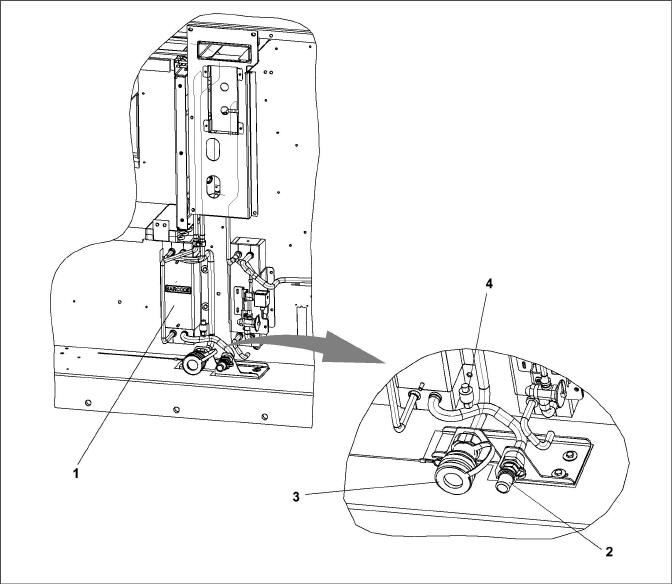
1.Water-Cooled Condenser (WCC)
2.Coupling - Water In
3.Self Draining Coupling - Water Out
4.Water Pressure Switch (WPS)
- - - - -
The control box (Figure 3.6) includes: the manual operation switches, circuit breaker (CB-1), compressor, fan and heater contactors, control power transformer, fuses, key pad, display module, current sensor module, controller module and the communications interface module.
3.1.8Communications Interface Module
The communications interface module is a slave module which allows communication between the refrigeration unit and a ship system master central monitoring station. The module will respond to communication and return information over the ships main power line. Refer to the master system technical manual for further information.
Figure 3.6 Control Box Section
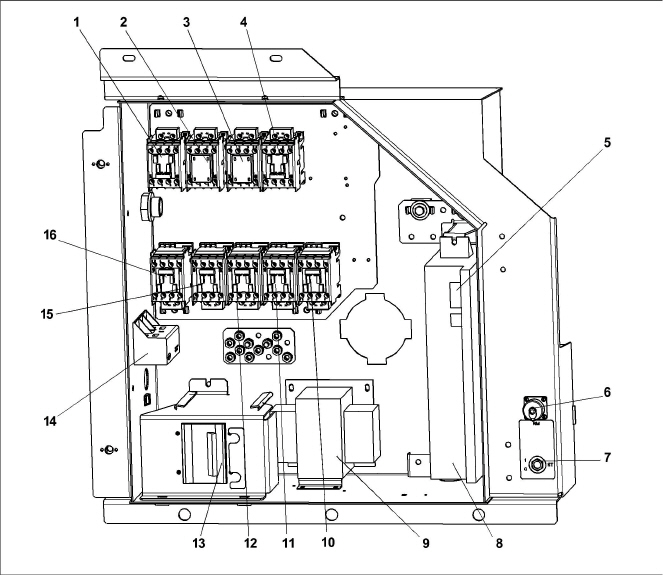
2.Compressor Phase A Contactor - PA
3.Compressor Phase B Contactor - PB
5.Controller/DataCORDER Module (Controller)
6.Remote Monitoring Receptacle
8.Controller Battery Pack (Standard Location)
10.High Speed Evaporator Fan Contactor - EF
11.Low Speed Evaporator Fan Contactor - ES
12.Condenser Fan Contactor - CF
15.Condenser Fan Low Speed - LC
16.Condenser Fan (High Speed Shorting) - FS
- - - - -
Circuit Breaker |
CB-1 (25 amp) |
Trips at 29 amps |
|
CB-2 (50 amp) |
Trips at 62.5 amps |
||
CB-3 (70 amp) |
Trips at 87.5 amps |
||
Compressor Motor |
Full Load Amps (FLA) |
13 amps @ 460 VAC |
|
Condenser Fan Motor |
|
380 VAC/3 PH/50 Hz |
460 VAC/3 PH/60 Hz |
Full Load Amps, High Speed |
0.73 |
0.80 |
|
Full Load Amps, Low Speed |
.42 |
.44 |
|
RPM, High Speed |
1425 rpm |
1725 rpm |
|
RPM, Low Speed |
720 rpm |
850 rpm |
|
Voltage and Frequency |
360 - 460 VAC +/-2.5Hz |
400 - 506 VAC +/-2.5Hz |
|
Bearing Lubrication |
Factory lubricated, additional grease not required. |
||
Rotation |
CW when viewed from shaft end. |
||
Evaporator Coil Heaters |
Number of Heaters |
6 |
|
Rating |
750 watts +5/-10% each @ 230 VAC |
||
Resistance (cold) |
6.8 to 77.2 ohms @ 20°C (68°F) |
||
Type |
Sheath |
||
Evaporator Fan Motors |
|
380 VAC/3 PH/50 Hz |
460 VAC/3 PH/60 Hz |
Full Load Amps |
1.07 |
0.9 |
|
Full Load Amps |
0.47 |
0.47 |
|
Rotations Per Minute |
2850 rpm |
3450 rpm |
|
Rotations Per Minute |
1425 rpm |
1725 rpm |
|
Voltage and Frequency |
360 - 460 VAC +/- 1.25Hz |
400 - 500 VAC +/- 1.5Hz |
|
Bearing Lubrication |
Factory lubricated, additional grease not required |
||
Rotation |
CW when viewed from shaft end |
||
Fuses |
Control Circuit |
7.5 amps (F3A,F3B) |
|
Controller / DataCORDER |
5 amps (F1 & F2) |
||
Emergency Bypass |
10 amps (FEB) |
||
Vent Position Sensor (VPS) |
Electrical Output |
0.5 VDC to 4.5 VDC over 90 degree range |
|
Supply Voltage |
5 VDC +/- 10% |
||
Supply Current |
5 mA (typical) |
||
Solenoid Valve Coils (ESV/USV) 24 VAC |
Nominal Resistance @ 77°F (25°C) |
7.7 ohms +/- 5% |
|
Maximum Current Draw |
0.7 amps |
||
DLV Coil 12 VDC |
Nominal Resistance @ 68°F (20°C) |
14.8 ohms +/- 5% |
|
DUV Coil 24VAC |
Nominal Resistance @ 68°F (20°C) |
15.5 ohms +/- 5% |
|
EEV Nominal Resistance |
Coil Feed to Ground (Gray Wire) |
47 ohms |
|
Coil Feed to Coil Feed |
95 ohms |
||
Humidity Sensor |
Orange wire |
Power |
|
Red wire |
Output |
||
Brown wire |
Ground |
||
Input voltage |
5 VDC |
||
Output voltage |
0 to 3.3 VDC |
||
Output voltage readings verses relative humidity (RH) percentage: |
|||
30% |
0.99 V |
||
50% |
1.65 V |
||
70% |
2.31 V |
||
90% |
2.97 V |
||
Controller |
Setpoint Range |
-35 to +30°C (-31 to +86°F) |
|
3.4Safety and Protective Devices
Unit components are protected from damage by safety and protective devices listed in Table 3–1. These devices monitor the unit operating conditions and open a set of electrical contacts when an unsafe condition occurs.
Open safety switch contacts on either or both of devices IP-CP or HPS will shut down the compressor.
Open safety switch contacts on device IP-CM will shut down the condenser fan motor.
The entire refrigeration unit will shut down if one of the following safety devices open: (a) circuit breaker(s); (b) fuse (F3A/F3B, 7.5A); or (c) evaporator fan motor internal protector(s) - (IP).
Starting at the compressor, (see Figure 3.7, upper schematic) the suction gas is compressed to a higher pressure and temperature.
The refrigerant gas flows through the discharge line and continues into the air-cooled condenser. When operating with the air-cooled condenser active, air flowing across the coil fins and tubes cools the gas to saturation temperature. By removing latent heat, the gas condenses to a high pressure/high temperature liquid and flows to the receiver, which stores the additional charge necessary for low temperature operation.
The liquid refrigerant continues through the liquid line, the filter drier (which keeps refrigerant clean and dry) and the economizer (not active during standard operation) to the electronic expansion valve (EEV).
As the liquid refrigerant passes through the variable orifice of the EEV, the pressure drops to suction pressure. In this process some of the liquid vaporizes to a gas (flash gas), removing heat from the remaining liquid. The liquid exits as a low pressure, low temperature, saturated mix. Heat is then absorbed from the return air by the balance of the liquid, causing it to vaporize in the evaporator coil. The vapor then flows through the suction tube back to the compressor.
During the standard mode of operation, the normally closed valves, digital loader valve (DLV) and digital unloader valve (DUV), control the system refrigerant flow and capacity by loading and unloading the compressor in frequent discrete time intervals. The DLV and DUV operate in opposition to each other such that when the DLV is closed the DUV is open and vice versa. The valves cycle on a fixed duty cycle so that maximum capacity occurs when the DLV is open 100% of the time and the DUV is open 0% and minimum capacity is when the DLV is open 0% of the time and the DUV 100% of the time. If the system capacity has been decreased to the lowest allowable capacity, the unit will enter a trim heat mode of operation, during which the controller will pulse the evaporator heaters in sequence with the compressor digital signal in order to absorb the excess capacity.
In the economized mode, (see Figure 3.8) the frozen and pull down capacity of the unit is increased by sub- cooling the liquid refrigerant entering the electronic expansion valve. Overall efficiency is increased because the gas leaving the economizer enters the compressor at a higher pressure, therefore requiring less energy to compress it to the required condensing conditions.
Liquid refrigerant for use in the economizer circuit is taken from the main liquid line as it leaves the filter drier. The flow is activated when the controller energizes the economizer solenoid valve (ESV).
The liquid refrigerant flows through the ESV to the economizer expansion valve internal passages, absorbing heat from the liquid refrigerant flowing to the electronic expansion valve. The resultant “medium” temperature/pressure gas enters the compressor at the economizer port fitting.
3.5.3Economizer Expansion Valve
The microprocessor controls the superheat leaving the economizer expansion valve (EXV). From the EXV the refrigerant flows through the internal passages of the economizer heat exchanger, absorbing heat from the refrigerant flowing to the EEV. The resultant “medium” temperature/pressure gas enters the compressor at the economizer port fitting.
Figure 3.7 Refrigeration Circuit Schematic - Standard Operation
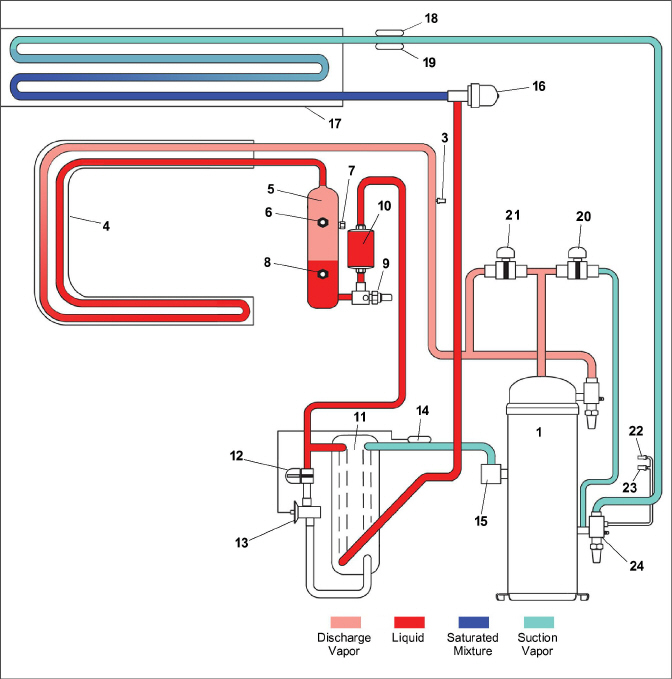
1.Compressor
2.Discharge Service Valve
3.Discharge Pressure Transducer (DPT)
4.Condenser
5.Receiver
6.Receiver Sight Glass
7.Fusible Plug
8.Receiver Liquid Level / Moisture Indicator
9.Liquid Line Service Valve
10.Filter Drier
11.Economizer
12.Economizer Solenoid Valve (ESV)
13.Economizer Expansion Valve (EXV)
14.Economizer Expansion Valve (EXV) Sensing Bulb
15.Economizer Connection
16.Electronic Expansion Valve (EEV)
17.Evaporator
18.Evaporator Temperature Sensor (ETS1)
19.Evaporator Temperature Sensor (ETS2)
20.Digital Unloader Valve (DUV)
21.Digital Loader Valve (DLV)
22.Evaporator Pressure Transducer (EPT)
23.Suction Pressure Transducer (SPT
24.Suction Service Valve
- - - - -
Figure 3.8 Refrigeration Circuit Schematic - Economized Operation
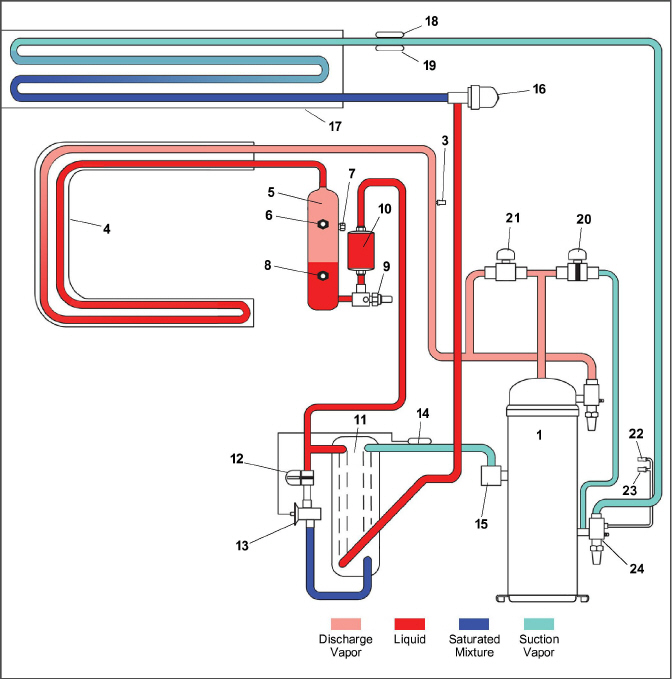
1.Compressor
2.Discharge Service Valve
3.Discharge Pressure Transducer (DPT)
4.Condenser
5.Receiver
6.Receiver Sight Glass
7.Fusible Plug
8.Receiver Liquid Level / Moisture Indicator
9.Liquid Line Service Valve
10.Filter Drier
11.Economizer
12.Economizer Solenoid Valve (ESV)
13.Economizer Expansion Valve (EXV)
14.Economizer Expansion Valve (EXV) Sensing Bulb
15.Economizer Connection
16.Electronic Expansion Valve (EEV)
17.Evaporator
18.Evaporator Temperature Sensor (ETS1)
19.Evaporator Temperature Sensor (ETS2)
20.Digital Unloader Valve (DUV)
21.Digital Loader Valve (DLV)
22.Evaporator Pressure Transducer (EPT)
23.Suction Pressure Transducer (SPT
24.Suction Service Valve
- - - - -
Figure 3.9 Refrigeration Circuit Schematic - Water-Cooled Condenser
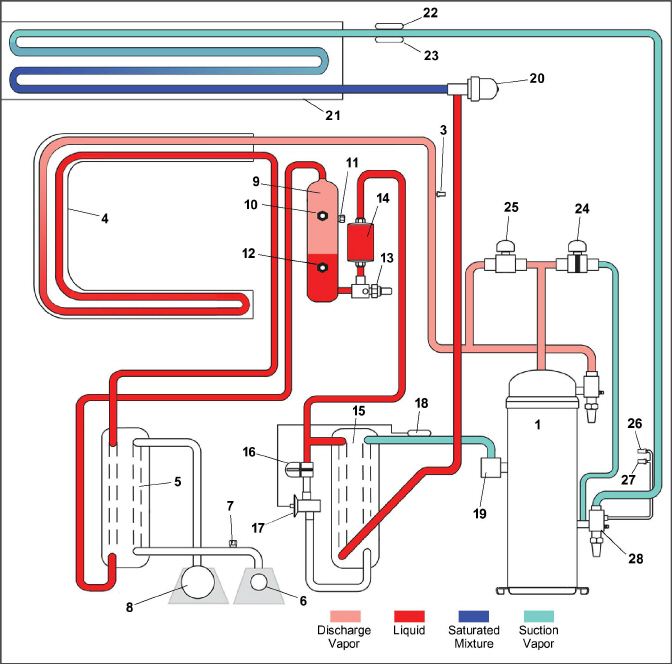
1.Compressor
2.Discharge Service Valve
3.Discharge Pressure Transducer (DPT)
4.Condenser
5.Water-Cooled Condenser
6.Coupling (Water In)
7.Water Pressure Switch
8.Coupling (Water Out)
9.Receiver
10.Receiver Sight Glass
11.Fusible Plug
12.Receiver Liquid Level / Moisture Indicator
13.Liquid Line Service Valve
14.Filter Drier
15.Economizer
16.Economizer Solenoid Valve (ESV)
17.Economizer Expansion Valve (EXV)
18.Economizer Expansion Valve (EXV) Sensing Bulb
19.Economizer Connection
20.Electronic Expansion Valve (EEV)
21.Evaporator
22.Evaporator Temperature Sensor (ETS1)
23.Evaporator Temperature Sensor (ETS2)
24.Digital Unloader Valve (DUV)
25.Digital Loader Valve (DLV)
26.Evaporator Pressure Transducer (EPT)
27.Suction Pressure Transducer (SPT
28.Suction Service Valve
- - - - -